by Barbara | Jun 20, 2022 | Blog
What are sawfish spotters?
Have you noticed some very cool looking people recently, wearing the SARA Sawfish Spotter’s t-shirts?
We are very proud of these t-shirts, which feature a drawing by the amazing Julius Csotonyi. The t-shirt raises awareness for the submission of sawfish sightings (historical and recent) to the SARA sawfish sightings campaign. YOU can submit your sighting here.
If you have received your t-shirt we would love you to tag us on social media @SharksAndRaysAU and use the #sawfishspotters to raise awareness for our sightings campaign and your awesomeness! Thank you for contributing to the conservation of these amazing critters!
Wearing a Sawfish Spotter t-shirt does not give permission to target sawfish in Australia, for sighting submissions or otherwise. Please remember, sawfish are endangered and protected under both state and federal legislations and there are steep fines for targeting these fish without a permit.
This t-shirt campaign is funded by our Queensland Government Office of the Chief Scientist Citizen Science grant, as well as a Save Our Seas Foundation small grant.
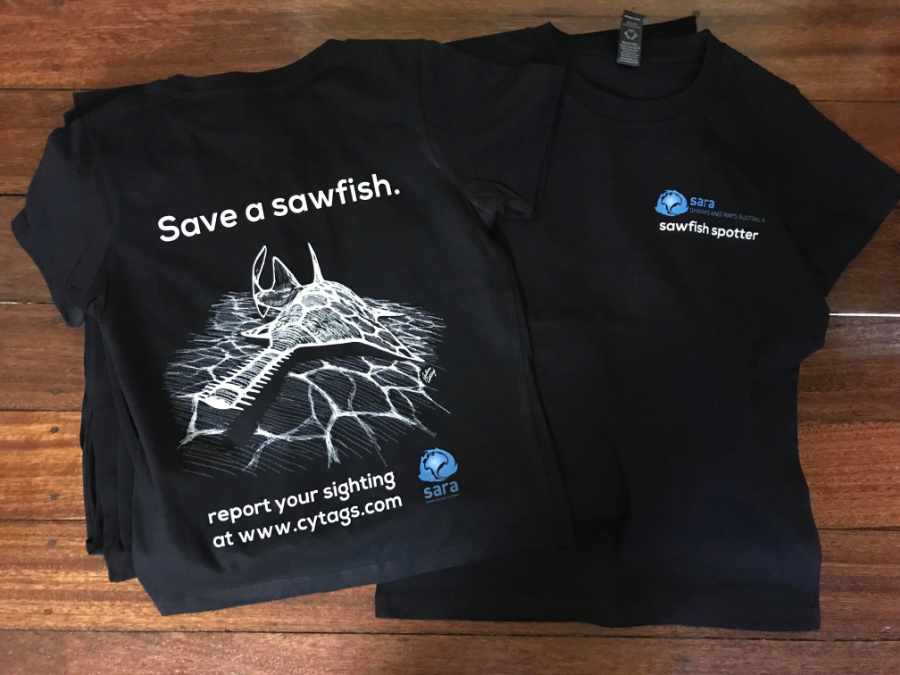
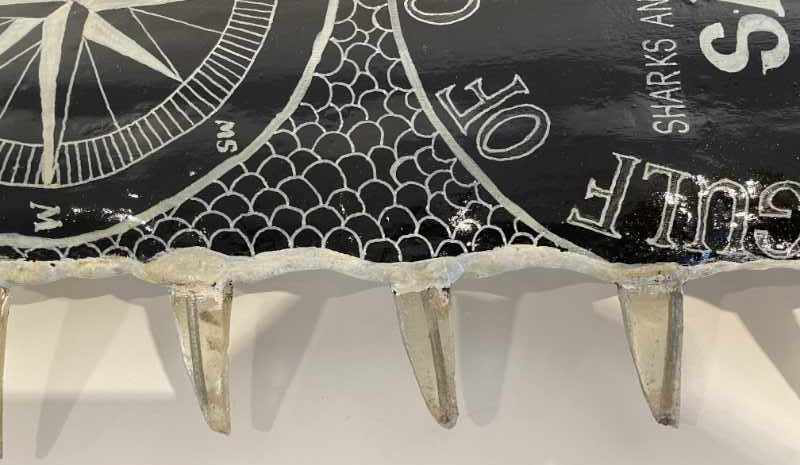
by Barbara | May 16, 2022 | Blog
In March 2022, i (Barbara) visited Karumba for a Queensland Fisheries meeting. During a break at the meeting, Rod Lucas popped in! I had never actually met him, but was aware of him and his sawfish art for a long time.
In 2019, I ran a field trip to Karumba, and as part of it we asked locals to allow us to sample their sawfish saws. This was the first time I came across one of Rod’s saw casts. As it was painted, it took us a few minutes to figure out what we were looking at.
Rod’s casts are for sale in the Les Wilson Barramundi Discovery Centre in Karumba. When I visited him there to see some more of his artworks, he had a surprise for me, a cast that he made as a gift for Sharks And Rays Australia. It is absolutely stunning! Check out the rostral teeth, he left them transparent, so that it’s visible that this is not a real sawfish saw.
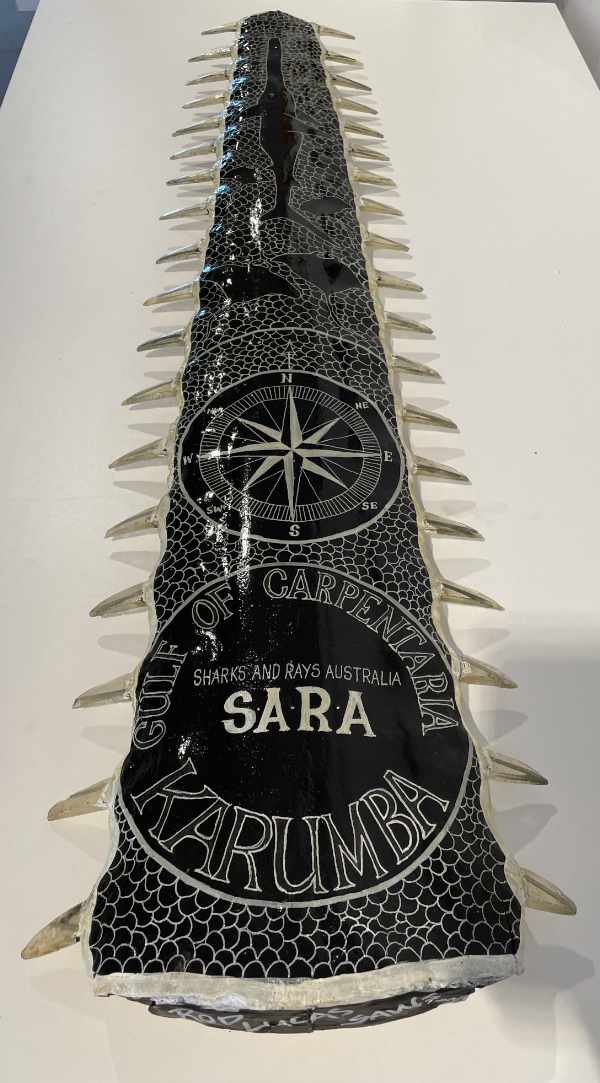 Rod’s creativity allows this important part of both Indigenous and also North Queensland culture, the display of sawfish saws, to continue into the future, without posing any harm to endangered species.
Rod’s creativity allows this important part of both Indigenous and also North Queensland culture, the display of sawfish saws, to continue into the future, without posing any harm to endangered species.
Link to ABC article on Rod Lucas’ work: https://www.abc.net.au/news/2022-02-15/karumba-artist-using-his-work-to-fight-for-endangered-sawfish/100828104
Rod Lucas Gallery https://www.rodlucasgallery.com.au/
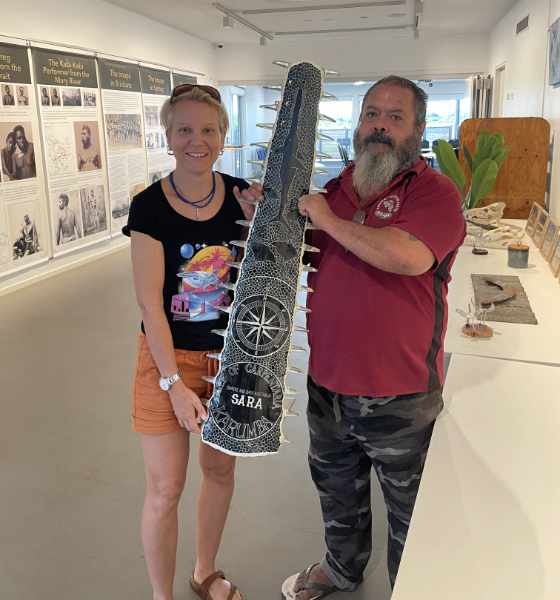
Dr Wueringer from SARA with artist Rod Lucas and the amazing saw he made for SARA.
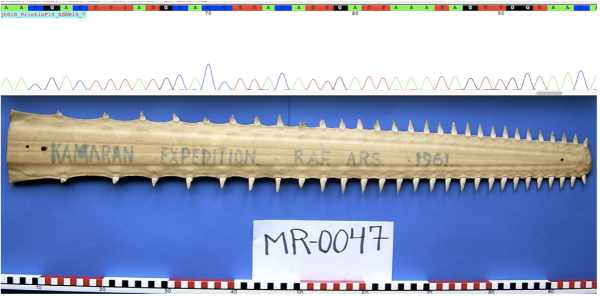
by Barbara | Mar 1, 2022 | Blog
By Annmarie Fearing, University of Mississippi
‘SawSearch’ is a collective research effort led by Dr. Nicole Phillips and Annmarie Fearing from the University of Southern Mississippi and Kelcee Smith from Louisiana State University. This project would not be possible without our collaborators from around the world, dedicated volunteers, and funding from Save Our Seas Foundation, Shark Conservation Fund, and The Curtis and Edith Munson Foundation. Thank you for being a part of our ‘SawSearch’ project and supporting our efforts to collect tissue samples from historic sawfish specimens. With your help we have collected over 1,500 tissue samples from all five species of sawfish from over 150 public and private natural history collections. Specimens originate from as far back as the 1600’s and span from origins around the globe such as West Africa (read more here), Nicaragua, Panama, and Bangladesh, among others. As we continue to collect and process these important samples, we wanted to provide you with a brief update.
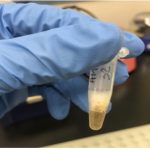 Historical Smalltooth Sawfish tissue being digested during DNA extraction. Image by Annmarie Fearing.
Historical Smalltooth Sawfish tissue being digested during DNA extraction. Image by Annmarie Fearing.
We experienced some setbacks due to COVID-19, but we are now back in the lab hard at work. We have extracted DNA from all Largetooth, Green, and Smalltooth Sawfish tissue samples and are currently sequencing and genotyping the DNA.
Thanks to your participation in this research, we have DNA sequence information from historic sawfish populations that would otherwise not be possible, such as the sequence shown below from a Green Sawfish saw collected from the Arabian Sea in 1961. You can read about our preliminary findings on the genetic diversity in Largetooth Sawfish in our blogs posted on our Save Our Seas Foundation project page.
The ‘SawSearch’ team has shared preliminary data from this research via public talks and scientific conferences. In 2019, Annmarie presented preliminary genetic data for Largetooth Sawfish at the Joint Meeting of Ichthyologists and Herpetologists in Utah, USA and Kelcee shared progress on her research on Smalltooth Sawfish at the Society for the Preservation of Natural History Collections (SPNHC) meeting in Illinois, USA. In February 2021, Nicole participated in a public presentation on sawfish for the
Wildlife in the Red program organized by Wessex Museums, which can be viewed
here. Additionally, Annmarie will be giving a talk at the 2022 SPNHC meeting in Scotland and may see some of you there.
For the remainder of the year, we will be dedicated to wrapping up the analyses of these data for publications, but we will still be on the search for more saws. We are currently working to gather additional samples from Papua New Guinea and Brazil, which would allow us to address uncertainties regarding the status of sawfish in these locations.
As we continue to collect more samples and expand our research we will be sure and keep you all updated. Thank you again for being a part of ‘SawSearch’!
Featured image caption: DNA sequence (above) from a Green Sawfish saw (below) from a sawfish captured at Masirah Island in the Arabian Sea in 1961.
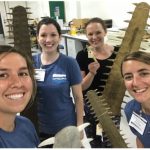 Annmarie Fearing (left), Nicole Phillips (middle left), Cat Gordon (middle right), and Kelcee Smith (right). Image by Annmarie Fearing.
Annmarie Fearing (left), Nicole Phillips (middle left), Cat Gordon (middle right), and Kelcee Smith (right). Image by Annmarie Fearing.
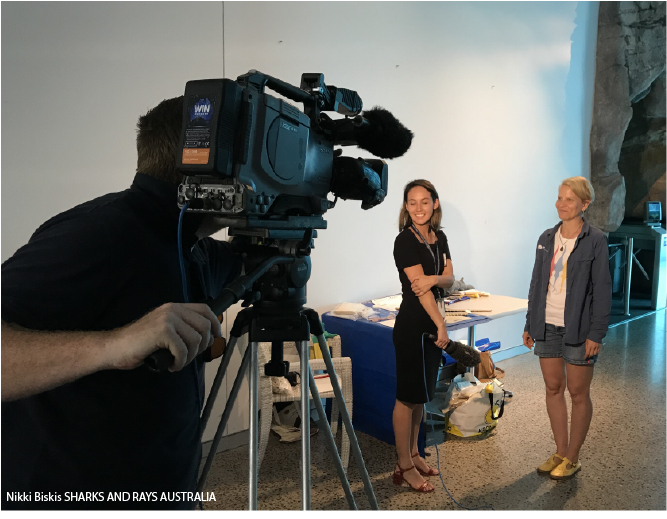
by Barbara | Jan 12, 2022 | Blog
Sharks And Rays Australia (SARA) is seeking up to three social media interns to support our team in science communication. You will help us communicate, our work, what is happening at SARA and news from the world of sharks, rays and above all sawfishes. Start date immediately.
Our core values and mission: At SARA we believe that long-term conservation goals can only be achieved if they are based on sound science, public outreach and an inclusive model of implementation, i.e. working with local stakeholders. SARA aims to not just produce science in the ‘ivory tower’ but to involve the general public in our sawfish and shark research expeditions. In many ways, it is ultimately up to local communities to look after the incredible species that share the natural world with us.
Our current work: At SARA, we like to think outside the box. Our current main study species, sawfish, are the most endangered of all sharks and rays globally, but they are much more than that. These large animals (up to 7m length) are culturally important to many Indigenous groups, and they were once amongst the most abundant large predators in tropical coastal, inshore and freshwater regions of our planet. Sitting somewhere between charismatic and dangerous megafauna, the work done by our principal scientist, collaborators, students, field assistants, interns, and volunteers ensures that these animals don’t quietly go extinct, and will remain a vital part of Northern Australia’s ecosystems.
Our creative, outcome-oriented, and dynamic work environment allows the creation and implementation of real-world conservation concepts that unite people with a common idea and goal.
- SARA is currently the only Australian organisation that allows paying field assistants to participate in shark and ray research expeditions, and gain hands-on research experience. Field work is led by our scientists and conducted in close collaboration with Aboriginal Land and Sea Rangers, and sometimes with commercial fishers, thus uniting all of us during intensive tagging workups of large animals.
- Our citizen science project turns members of the public into sawfish spotters by turning old trophy saws into messengers for conservation. Cases inform the public about sawfish biology, possible threats, and safe release methods. Our sawfish display cases and info boards can be seen at 60 locations (and growing) across Queensland.
Our social media interns will be responsible for content creation for one of our three platforms (@SharksAndRaysAU on Facebook, Instagram, Twitter), thus supporting our existing science and social media team. Content sourcing, and creating content from existing materials will also fall in the intern’s responsibilities. Creation of ads is outside of the scope of this role.
This position is unpaid, as we currently do not have funding for it. However, in order to gain understanding of the work that we do, you will very likely be able to join one of our field trips in 2021 for free (details to be worked out individually). Your internship will also result in a letter of recommendation from our Principal Scientist and Director. Additional perks include: SARA merchandise and opportunity to travel to sharky events.
If interested please send a cover letter and CV to hello@saw.fish attn: Dr Barbara Wueringer. The cover letter should contain the following information:
- Statement of interest: Why are you interested in this position?
- Which platform you would like to administer
- Your strategy to find info for creating exciting posts
- 2-3 sample posts
- Availability (e.g. one semester, 1 year)
- Number of hours per week you would like to commit to
- Where you are based
Please note that where you are based will not affect our decision.
by Barbara | Dec 1, 2021 | Blog
Summary: SARA-r is recruiting board directors to grow our new entity. The directors will lead our strategic vision, consistent with our core values and aims. While the Board of Directors oversees and provides insight into the business direction of SARA-r, it also works closely with the Research Board and Principal Scientist. Our creative, outcome-oriented, and dynamic work environment allows the creation and implementation of real-world conservation concepts, that unite people with a common idea and goal.
Org: Sharks And Rays Australia Research Ltd
- Term: 3 yrs
- Hours: 8-16 hrs per month, flexible
- Reports to: the board
About Sharks And Rays Australia Research Ltd.
SARA-r was founded by SARA Pty Ltd in 2021, to expand our ongoing work with endangered sharks and rays, including sawfish, both in Queensland (field work, collaborations with Aboriginal Land and Sea Ranger groups, collaborations with local schools) and Australia wide (Citizen science project identifying sawfish distributions). As a not-for-profit research organisation, the governance of SARA-r is divided into the business side (board of directors) and the research side (research board). Our research board brings together 7 internationally renowned biologists, who represent essential expertise on the unique sharks and rays of Northern Australia.
Our core values and mission: At SARA-r we believe that long-term conservation goals can only be achieved if they are based on sound science, public outreach and an inclusive model of implementation, i.e. working with local stakeholders. SARA-r aims to not just produce science in the ‘ivory tower’ but to involve the general public in our sawfish and shark research expeditions. In many ways, it is ultimately up to them to look after the incredible species that share the natural world with us.
Our current work: At SARA-r, we like to think outside the box. Our current main study species, sawfish, are the most endangered of all sharks and rays globally, but they are much more than that. These large animals (up to 7m length) are culturally important to many Indigenous groups, and they were once amongst the most abundant large predators in tropical coastal, inshore and freshwater regions of our planet. Sitting somewhere between charismatic and dangerous megafauna, the work done by our principal scientist, collaborators, students, field assistants, interns, and volunteers, ensures that these animals don’t just quietly go extinct, but will remain a vital part of Northern Australia’s ecosystems.
Our creative, outcome-oriented, and dynamic work environment allows the creation and implementation of real-world conservation concepts, that unite people with a common idea and goal.
- SARA is currently the only Australian organisation that allows paying field assistants to participate in shark and ray research expeditions, and gain hands-on research experience. Field work is led by our scientists and conducted in close collaboration with Aboriginal Land and Sea Rangers, and sometimes with commercial fishers, thus uniting all of us during intensive tagging work-ups of large animals.
- Our citizen science project turns members of the general public into sawfish spotters, and spreads the word on sawfish and their biology by turning old trophy saws into messengers for conservation. Our sawfish display cases and boards can be seen at 60 locations across Queensland.
Vacancies: As SARA is growing and restructuring to SARA-r, we are seeking a board of directors that will offer leadership and governance in their complementary fields of expertise. SARA-r is seeking to appoint up to four highly motivated Non-Executive Directors.We aim to establish a diverse board, comprising directors with a broad range of skills and life experience. All directors must have, or be already working towards gaining, an understanding of the governance principles of an Australian not for profit organisation (company limited by guarantee). Directors need to be team players who can also work independently. We are looking for enthusiastic individuals who are residing in Australia.
We are seeking expressions of interest from individuals with qualifications, skills and/or experience in any of the followingareas:
Essential:
- Law (corporations, NFP sector, environmental, tax, contract)
- Governance (corporate, environmental)
- IT (Public relations / marketing / communication)
- Philanthropy / fundraising / campaigning
- Finance / accounting (audit, NFP sector, tax)
- Ability to actively participate in strategic decision making
Desirable:
- Ability to share and engage professional networks and relationships to the mission of SARA-r
- Experience in working with various levels of government
- A sound understanding of the principles of conservation biology, ecological management, endangered species management and a willingness to expand this knowledge in pursuit of SARA-r’s mission.
Key selection criteria: SARA-r board members are expected to:
- Demonstrate a strong commitment to the mission and values of SARA-r
- Demonstrate experience in strategic planning that may come from business, management experience or not-for-profit organisations
- Lead a culture of collaboration, transparency and collegiality where board peers and organisational staff/volunteers feel engaged and respected
- Thrive in an outcome-oriented environment
- Provide evidence of knowledge of ACNC and ASIC governance principles and demonstrate a commitment to working according to these principles
- Demonstrate initiative and innovative thinking
Time, commitment, term and expenses: Board duties include: 3 board meetings per year (3hr each, strategic planning, operational planning, board evaluation), ability to oversee specific portfolios (treasurer, secretary, chair, plus essential items listed above). The time commitment will vary throughout term (i.e. inductions and meeting other directors at beginning) and year (i.e. interim meetings of committees as required). This is a volunteer position. All meetings will take place virtually.
The first round of applications for this position closed in November 2021, but we are always interested in expanding our team and horizons with the right people. To apply for this position, please email a cover letter outlining answers to the following questions, along with your CV, to Dr Barbara Wueringer (barbara@saw.fish).
- Why are you interested in joining the board of directors of SARA-r?
- What skills, knowledge and experience would you bring to the board?
- What do you hope to get from joining our board of directors?
If you have any questions please call us on 1800 298 247.
Access a flyer here.








